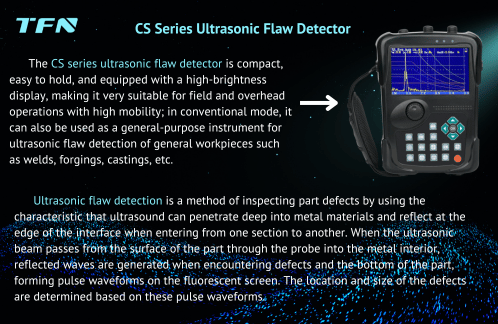How to use ultrasonic flaw detectors in railway inspection and maintenance
In the railway transportation system, the safety inspection and maintenance of track and vehicle components are key links to ensure the smooth operation of trains and the safety of passengers. As a non-destructive detection technology tool, ultrasonic flaw detectors are widely used in railway inspection and maintenance, and can accurately identify and locate defects inside track and vehicle components. The following will introduce in detail the working principle, application aspects and detailed inspection and maintenance steps of ultrasonic flaw detectors.
1. Working principle
Ultrasonic flaw detectors work based on the principle of ultrasonic wave propagation in materials. When ultrasonic waves encounter defects in materials (such as cracks, inclusions, voids, etc.), reflection, refraction or scattering will occur. The flaw detector emits high-frequency ultrasonic signals and receives the reflected waves after these signals propagate in the material, thereby judging whether there are defects inside the material. These reflected waves are converted into electrical signals, which are processed and displayed in the form of images or data for inspection personnel to analyze and judge.
2. Applications
The application of ultrasonic flaw detectors in railway inspection and maintenance mainly includes the following aspects:
2.1. Railway axle detection
Railway axles are key components for the safe operation of trains. Ultrasonic flaw detectors can detect internal defects in axles to ensure that there are no potential safety hazards such as cracks and inclusions in the axles. During the inspection, the probe of the flaw detector will emit an ultrasonic signal, which will propagate through the inside of the axle and reflect back. According to the characteristics of the reflected wave, the inspector can determine whether the axle has defects and repair or replace it in time.
2.2. Rail weld inspection
Rail welds are the weak link in the track system and are prone to cracks and fatigue damage. Ultrasonic flaw detectors can accurately detect defects inside the welds to ensure the integrity and reliability of the welds. During the inspection, the probe moves back and forth at the weld and conducts detailed inspections from different angles. The flaw detector can capture the reflected waves inside the weld and generate detailed test results to help inspectors discover and deal with potential safety hazards in a timely manner.
2.3. Overall track inspection
In addition to local inspection of axles and welds, ultrasonic flaw detectors can also be used for overall track inspection. By moving the flaw detector along the track, the inside of the track can be scanned in detail to detect fatigue damage, cracks and other defects. This detection method can ensure the overall safety and reliability of the track system and provide strong protection for railway transportation.
2.4. Combination of dynamic detection technologies
In railway inspection and maintenance, ultrasonic flaw detectors are usually combined with other dynamic detection technologies, such as axle temperature detection and operation quality detection. These technologies together constitute a complete detection system that can monitor and analyze various parameters during train operation in real time to ensure the safety and reliability of railway transportation.
3. Application steps
3.1. Preparation stage
Equipment inspection and calibration: Before using the ultrasonic flaw detector, you first need to conduct a detailed inspection of the equipment to ensure that the instrument is in good working condition. Calibrate the flaw detector to ensure the accuracy and reliability of the measurement. This usually includes calibration of parameters such as probe frequency, sensitivity, and gain.
Select a suitable probe: Select a suitable ultrasonic probe according to the material type, thickness, and expected defect type of the inspected part. The probe should have good coupling and penetration to accurately capture ultrasonic signals.
Determine the inspection area: According to the needs of railway inspection and maintenance, determine the specific areas that need to be inspected, such as rail welds, axles, etc. Mark the inspection area for detailed recording and analysis later.
3.2. Inspection stage
Set inspection parameters: According to the characteristics of the inspected part and the inspection requirements, set the inspection parameters of the ultrasonic flaw detector, such as transmission frequency, gain, scanning speed, etc. Ensure that the parameters are set reasonably to accurately capture ultrasonic signals and identify defects.
Coupling and transmitting ultrasonic waves: Apply an appropriate amount of coupling agent to the inspection area to ensure good contact between the probe and the inspected part. Start the ultrasonic flaw detector and transmit the ultrasonic signal into the inspected component.
Receive and analyze the signal: When the ultrasonic signal propagates inside the inspected component and encounters a defect, a reflected wave is generated. The flaw detector receives the reflected wave and converts it into an electrical signal, which is displayed on the screen. The inspector analyzes and identifies the type, location and size of the defect based on the waveform and image on the screen.
Record and mark defects: For the detected defects, record their detailed information, including location, size, type, etc. Mark the defect location in the inspection area for subsequent repair or replacement.
3.3. Subsequent processing stage
Evaluate the impact of defects: Based on the detected defect information, evaluate its impact on the safety and reliability of track and vehicle components. Determine whether the defective parts need to be repaired or replaced immediately.
Develop a repair plan: Based on the evaluation results, develop a detailed repair plan, including repair methods, required materials, repair time, etc. Ensure that the repair plan complies with relevant standards and regulations, and ensure that the repaired parts meet safety requirements.
Implement repair and monitoring: Implement the repair work according to the repair plan to ensure that the defects are properly handled. After the repair, use the ultrasonic flaw detector for re-inspection again to ensure that the defects have been completely eliminated. Repaired components are regularly monitored to ensure their long-term stability and safety.
4. Summary and Feedback
Organize the test results: organize all the data and results of the test process to form a detailed test report. The report should include key contents such as the test area, defect information, and repair plan.
Feedback and improvement: Feedback the test results and repair plan to relevant departments and personnel so that timely measures can be taken. According to the test results and feedback, the test methods and processes are continuously improved to improve the test efficiency and accuracy.
Through the above steps, the ultrasonic flaw detector can give full play to its non-destructive and accurate advantages in railway inspection and maintenance, and provide strong guarantees for the safe operation of railway transportation.
TFN CS series ultrasonic flaw detectors have the characteristics of high detection accuracy and fast detection speed. They can accurately detect defects in key parts such as rails and welds, provide timely maintenance information, and ensure the safety and stability of railway operation. Its portability and high-brightness display are also suitable for outdoor and highly mobile detection operations.


If you are interested in TFN CS series ultrasonic flaw detectors, please contact TFN sales team:
Email: info@tfngj.com
WhatsApp: +86-18765219251
Facebook: https://www.facebook.com/tfnfate/
